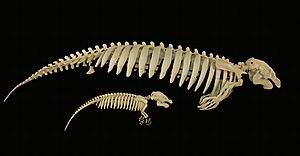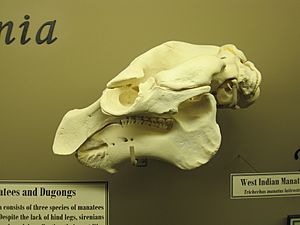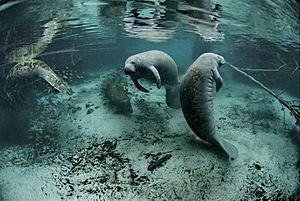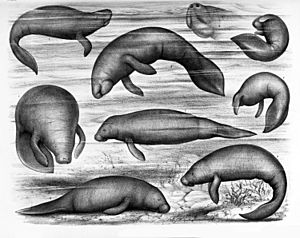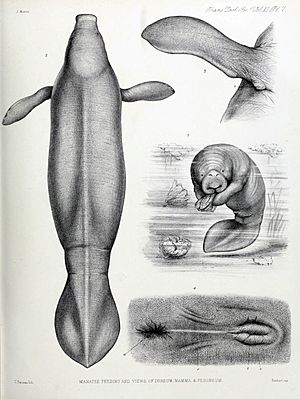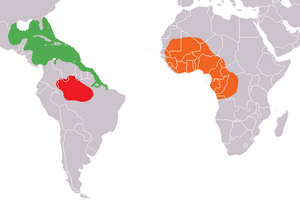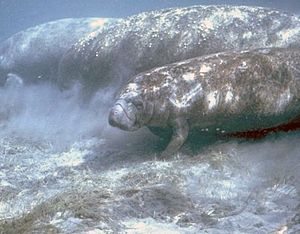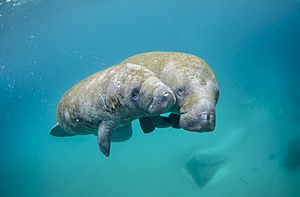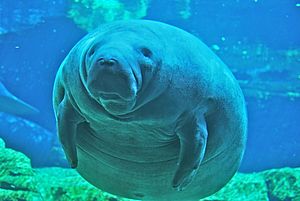Manatee facts for kids
Quick facts for kids Manatees |
|
|---|---|
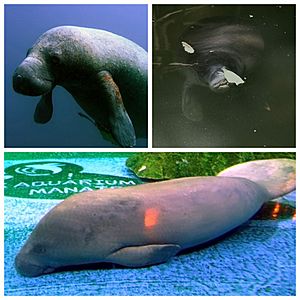 |
|
| Clockwise from upper left: West Indian manatee, Amazonian manatee, African manatee | |
| Scientific classification |
|
| Kingdom: | Animalia |
| Phylum: | Chordata |
| Class: | Mammalia |
| Order: | Sirenia |
| Family: | Trichechidae |
| Subfamily: | Trichechinae |
| Genus: | Trichechus Linnaeus, 1758 |
| Type species | |
| Trichechus manatus Linnaeus, 1758
|
|
| Species | |
|
|
| Synonyms | |
|
|
Manatees are large, gentle marine mammals. They live in water and mostly eat plants. People sometimes call them "sea cows" because they are slow and peaceful, like cows.
There are three main types of manatees alive today. These are the Amazonian manatee, the West Indian manatee, and the West African manatee. Manatees can grow up to 4 meters (13 feet) long and weigh as much as 590 kilograms (1,300 pounds). They have unique paddle-shaped tails.
Manatees are herbivores, meaning they only eat plants. They enjoy over 60 different kinds of plants from both fresh and saltwater. You can find them in shallow, marshy areas along coasts and in rivers. They live in places like the Caribbean Sea, the Gulf of Mexico, the Amazon basin, and West Africa.
Sadly, humans cause most manatee deaths. This includes losing their homes (habitat destruction) and hitting human objects. Because manatees move slowly and are curious, they often get hit by boats. Some manatees have more than 50 scars from boat propellers. Natural threats include cold weather, crocodiles eating young manatees, and diseases.
Contents
What's in a Name?
The word "manatee" might come from the Latin word manus, meaning "hand." It could also come from the Carib word manaty, meaning "breast." The nickname "sea cow" comes from their calm, plant-eating nature, similar to cows.
Manatee Family Tree
Manatees belong to a group of animals called Sirenia. There are four living species in this group. Three are manatees, and the fourth is the dugong, which lives in the Eastern Hemisphere. Scientists believe that sirenians evolved from four-legged land mammals over 60 million years ago. Their closest living relatives are elephants and hyraxes.
What Do Manatees Look Like?
Manatees usually weigh between 400 and 550 kilograms (880 to 1,210 pounds). They are about 2.8 to 3 meters (9 to 10 feet) long. Some can grow up to 4.6 meters (15 feet) and weigh 1,775 kilograms (3,913 pounds). Female manatees are usually bigger and heavier than males.
Baby manatees, called calves, weigh about 30 kilograms (66 pounds) when they are born. Female manatees have two teats, one under each flipper. This is a unique feature that made early scientists connect them to elephants.
Manatees have small eyes that are far apart. Their eyelids close in a circular way. They have a large, flexible upper lip that they use to grab food. This lip is also important for social interactions and communicating with other manatees. Manatees have shorter snouts compared to dugongs.
Manatee Teeth
Adult manatees do not have front teeth (incisors or canines). They only have cheek teeth, which are like molars. These teeth are replaced throughout their lives. New teeth grow at the back of the mouth and slowly move forward as the older teeth fall out. This is similar to how elephants' teeth work. A manatee usually has no more than six teeth in each jaw at any time.
The manatee's tail is shaped like a paddle. This is the easiest way to tell them apart from dugongs, whose tails are shaped like a whale's fluke. Manatees are unusual among mammals because they only have six neck bones (cervical vertebrae). Most other mammals have seven.
Like horses, manatees have a simple stomach. However, they have a very large cecum, which helps them digest tough plant material. Their intestines are also very long, about 45 meters (148 feet).
How Manatees Evolved
Fossils of manatee ancestors, called sirenians, date back to the Early Eocene period. It is thought that they reached South America and became the group known as Trichechidae (manatees). In the Late Miocene, manatees likely lived in South American coastal rivers and ate freshwater plants. Dugongs lived in the West Atlantic and Caribbean and ate seagrass. As seagrass grew more, manatees adapted by growing extra molars. Changes in sea levels and increased erosion also affected their teeth because they are bottom-feeders.
Manatee Behavior
Manatees are usually solitary animals. The only exceptions are mothers with their calves, or males following a female ready to mate. Manatees spend about half their day sleeping underwater. They come up for air regularly, usually every 20 minutes or less. The rest of their time is spent grazing in shallow waters, usually 1 to 2 meters (3 to 7 feet) deep. Some Florida manatees have been known to live up to 60 years.
How Manatees Move
Manatees typically swim at speeds of about 5 to 8 kilometers per hour (3 to 5 mph). However, they can swim much faster in short bursts, reaching up to 30 kilometers per hour (19 mph).
Manatee Intelligence
Manatees are smart animals. They can learn to tell things apart and show signs of complex learning. They also have good long-term memory. Studies show their learning abilities are similar to dolphins. Manatees have complex social interactions, which suggests they might be more intelligent than once thought. However, scientists are still learning about this.
Manatee Reproduction and Life Cycle
Manatees usually have one calf every two years. Pregnancy lasts about 12 months. The calf then nurses for another 12 to 18 months.
How Manatees Communicate
Manatees make many different sounds to communicate, especially mothers and their calves. Their ears are small on the outside but large inside, located behind each eye. Adult manatees use sounds to stay in touch with each other. They might also use taste, smell, sight, and touch to communicate.
What Manatees Eat
Manatees are herbivores. They eat over 60 types of plants from fresh and saltwater. This includes plants like water hyacinth, pickerel weed, and various seagrasses. An adult manatee can eat 10% to 15% of its body weight each day, which is about 50 kilograms (110 pounds) of plants. To eat this much, they graze for up to seven hours a day. Manatees use a special digestion process called hindgut fermentation to break down tough plant matter. Sometimes, manatees have been seen eating small numbers of fish from nets.
How Manatees Eat
Manatees use their flippers to "walk" along the bottom of the water. They dig for plants and roots in the mud. When they find plants, they use their flippers to scoop the plants towards their mouth. Manatees have special lips that can grab things. Their upper lip is split into two sides that can move separately. Seven muscles help their lips grab and tear plants. They use their lips and front flippers to move plants into their mouth. Manatees don't have front teeth, but they have hard, ridged pads on the roof of their mouth. These pads, along with their lower jaw, help them tear up the plants they eat.
Manatee Teeth Replacement
Manatees have four rows of teeth. There are 6 to 8 molars on each side of their upper and lower jaws, making a total of 24 to 32 flat, rough teeth. Eating gritty plants wears down their teeth. To make up for this, manatee teeth are always being replaced. When the front molars wear out, they fall off. New molars grow at the back of the jaw and slowly move forward to replace the old ones, like a conveyor belt. This process continues throughout the manatee's life. The speed at which teeth move forward depends on how fast the front teeth wear down.
Manatee Homes and Habitats
Manatees live in shallow, marshy coastal areas and rivers. The West Indian manatee (T. manatus) lives in the Caribbean Sea and the Gulf of Mexico. The Amazonian manatee (T. inunguis) lives in the Amazon basin. The West African manatee (T. senegalensis) lives along the west coast of Africa.
West Indian manatees prefer warm water. They often gather in shallow areas and travel between salty estuaries and freshwater springs. They cannot survive in water colder than 15 °C (60 °F). In winter, they find warmth in natural springs.
West Indian Manatees
The state of Georgia is usually the northernmost place West Indian manatees go. This is because their bodies don't keep them warm enough in cold water. Staying in water below 20 °C (68 °F) for too long can make them sick and even kill them.
West Indian manatees can move between fresh and salt water. However, they can get dehydrated if they don't have freshwater for a long time. Manatees can travel hundreds of miles each year. They have been seen as far north as Cape Cod and even in New York City.
In winter, manatees often gather near warm water coming from power plants along the Florida coast. Some people worry that manatees are becoming too dependent on these artificial warm spots. The U.S. Fish and Wildlife Service is looking for new ways to heat water for manatees if these plants close.
Counting manatees in Florida is hard because numbers change a lot each year. In January 2010, over 5,000 manatees were counted in Florida, which was the highest number at that time. As of January 2018, about 6,100 manatees were estimated to be in Florida.
In 2016, the U.S. Fish and Wildlife Service changed the manatee's status from "endangered" to "threatened." This means they are still protected but are considered less at risk. This decision caused some debate, but it does not change their current protections.
A small group of Antillean manatees lives in Mexico's Caribbean coastal area. About 200-250 of them are estimated to live there. A new manatee habitat was recently found in the cenotes (underwater caves) of the Sian Kaʼan Biosphere Reserve in Mexico.
Amazonian Manatees
The freshwater Amazonian manatee (T. inunguis) lives in the Central Amazon Basin in Brazil, eastern Perú, and southeastern Colombia. It is the only manatee that lives only in freshwater and is also the smallest. They are found mainly in tropical waters because they cannot easily reduce heat loss from their bodies.
West African Manatees
West African manatees live in coastal marine areas, estuaries, and freshwater river systems along the west coast of Africa. Their range extends from the Sénégal River south to the Cuanza River in Angola. They can be found far upriver on the Niger River, as much as 2,000 kilometers (1,200 miles) from the coast.
Threats to Manatees
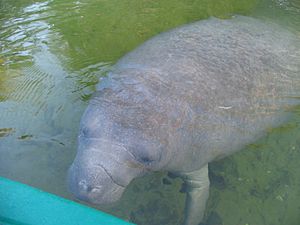
Humans are the biggest threat to manatees. This includes losing their homes and hitting human objects. Natural threats like cold weather, crocodiles eating young manatees, and diseases also occur.
Boat Strikes
Manatees are slow and curious, which often leads to them being hit by boats. These collisions can cause serious injuries, disfigurement, and death. Many manatees have spiral scars on their backs from boat propellers. Some manatees have been cut in half by large ships. It is very sad to see manatees with over 50 scars from boat strikes. These injuries can lead to infections, which can be deadly. Internal injuries from being trapped between boats and docks can also be fatal.
Scientists are studying how manatees hear boat sounds. Manatees can hear speed boats, but they might not hear slower, larger boats because those boats make very low-frequency sounds. This can confuse manatees and explain why they don't always move away from danger. Research shows that manatees swim away quickly when a boat makes a higher frequency sound.
In 2003, a study predicted a very serious future for manatees if boat deaths continued to increase. The study said that boat strikes cause about a quarter of all manatee deaths in Florida. In 2009, 97 out of 429 manatee deaths in Florida were caused by boats.
Red Tide
Another cause of manatee deaths is "red tides." These are blooms of tiny marine algae called Karenia brevis. These algae produce toxins that can harm the nervous system of animals. In 1996, a red tide killed 151 manatees in Florida. Other red tides in 1982, 2005, and 2022-2023 also caused many manatee deaths.
Starvation
In 2021, a huge amount of seagrass died off the Atlantic coast of Florida. This left manatees without enough food. Many manatees started dying from starvation. In early 2022, the U.S. Fish and Wildlife Service started a program to feed the malnourished manatees. They distributed 1,361 kilograms (3,000 pounds) of lettuce per day.
Other Dangers
Manatees can also get crushed or trapped in water control structures like navigation locks and floodgates. They sometimes get caught in fishing gear, such as crab pot lines and nets.
While people can swim with manatees in some areas of Florida, there have been many cases of people bothering them. About 99 manatee deaths each year are related to human activities. It is against federal and Florida law to hurt a manatee.
Protecting Manatees
All three species of manatee are considered vulnerable to extinction by the World Conservation Union. However, the United States Fish and Wildlife Service (FWS) changed the West Indian manatee's status from "endangered" to "threatened" in March 2017. They made this change because habitats have improved, populations have grown, and threats have decreased. This reclassification was debated, but it does not remove federal protections.
Manatee deaths in Florida almost doubled in 2021, from 637 in 2020 to 1,100. Although this number decreased in 2022, ongoing development, climate change, and declining water quality might lead to the West Indian Manatee being reclassified as endangered again. In the 1970s, only a few hundred manatees lived in the United States. By February 2016, over 6,250 manatees were reported in Florida's springs.
Many groups are working to protect manatees. The Save the Manatee Club is a non-profit organization that works to protect manatees and their water homes. It was started by former Florida governor Bob Graham and singer Jimmy Buffett.
In Brazil, hunting manatees was outlawed in 1973 to help protect them. However, deaths from boat strikes are still common. Even though some countries protect Amazonian manatees, there were no enforced laws in 1994, and manatees were still being captured.
Manatees in Zoos and Aquariums
There are several manatee rescue centers in the United States. Three main facilities in Florida are at ZooTampa at Lowry Park, Miami Seaquarium, and SeaWorld Orlando. After initial treatment, manatees are moved to rehabilitation centers before being released back into the wild.
You can also see manatees in many European zoos, like the Tierpark Berlin in Germany and the Aquarium of Genoa in Italy. The River Safari in Singapore also has seven manatees.
The oldest manatee in captivity was Snooty, who lived at the Bishop Museum of Science and Nature in Florida. Snooty was born on July 21, 1948, and was one of the first manatees born in captivity. He lived his entire life in captivity and was allowed to interact with human handlers. This made him very important for manatee research and education. Snooty sadly died on July 23, 2017, at 69 years old. He was found in an underwater area that was usually closed off.
Manatees in Guyana
Since the 1800s, Georgetown, Guyana has kept West Indian manatees in its botanical garden and national park. In the 1910s and 1950s, sugar farms in Guyana used manatees to keep their irrigation canals free of weeds. From the 1950s to the 1970s, the Georgetown water treatment plant also used manatees for the same purpose in their storage canals.
Manatees in Culture
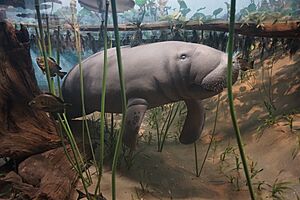
Manatees have been linked to old stories about mermaids. In West African folklore, manatees were considered sacred. People believed they were once human, and killing one was forbidden and required a special apology.
In the famous novel Moby-Dick, Herman Melville talks about manatees. He calls them "Lamatins" and says they are not whales because they don't spout water and live in rivers.
A manatee character named Wardell appears in the video game Animal Crossing: New Horizons. He helps manage and sell furniture in a game expansion.
In Rudyard Kipling's story The White Seal from The Jungle Book, there is a character called Sea Cow, who is a manatee. The story mentions that he only has six neck bones.
See also
 In Spanish: Manatíes para niños
In Spanish: Manatíes para niños


